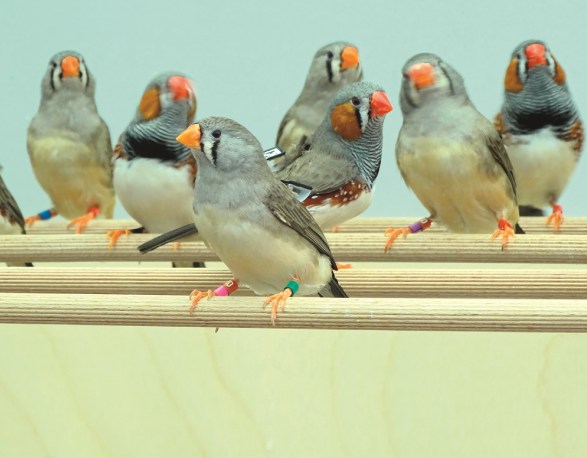Social stability, key in animal cooperation
By: Magda Páez Torres
Photos:
Environment

By: Magda Páez Torres
Photos:
Alone or in groups, birds usually trill with their songs of life in the countryside and even break—for moments— the rudeness of cities. However, behind their sweet melodies, these birds hide particularities that reveal that humans and animals may share more traits than the ones that are merely perceptible.
An investigation carried out by Professor Adriana Maldonado Chaparro, from Universidad del Rosario, and researchers Gustavo Alarcón Nieto, James Klaveras Irby, and Damien Farine, from the Max Planck Institute for Animal Behavior in Germany, reinforces the hypothesis that animal societies are not as stable as has been previously considered
The researchers reached this conclusion after advancing an experiment with captive populations of zebra finches, an Australian species with a high resistance to captivity, that has been studied in different areas of the world to understand the behavior of birds.
In general, it is perceived that, as with humans, some species are often impacted by ruptures in their daily routines or by disturbances of various kinds, which ultimately affect their coexistence and their ability to cooperate.
oexistence and their ability to cooperate. The study, published in the journal Proceedings of the Royal Society, lasted approximately three months and was conducted with the aid of technology to achieve a millimetric follow-up on the behavior of birds. “The first step was to design what we call an automatic monitoring backpack, also developed by us, which is assembled over a harness around the body and has a structure where a barcode is placed, which allows us to identify each individual. Monitoring is done with a camera similar to that of a cell phone, which captures video, so as to have a continuous record of birds’ behavior”, explains Professor Adriana Maldonado Chaparro.
The cameras were located over the feeding areas, where birds were given a daily supply off —in the morning and in the afternoon—a certain amount of zucchini, which was weighed before and after consumption and was left in the cage for 45 minutes. ““It was a reward, similar to giving candy to a child. As these birds are eating seeds all day, providing this slice of zucchini, which has a high content of nutrients and a higher water content, means the birds will eat it faster than they would eat the seed,”, says Gustavo Alarcón Nieto.
This exercise was carried out without any variations for a month, with the researchers keeping a record of the observed behavior of the 28 birds that shared the cage. Following this period, the stage of disturbances began.“This period comprised a series of repeated disturbances. We took all the individuals and divided them into three aviaries, distant from each other, where they could not hear each other, could not see each other, and remained separated for two days”, says the researcher from Universidad del Rosario.
According to expert Gustavo Alarcón Nieto, the researchers sought to simulate what would happen if a predator arrived and forced the birds to separate—namely to flee in different directions—and later, meet again.
uring the separation, their supply of zucchini was suspended, and the normal diet was maintained with seeds. After two days, the birds were reunited in the main cage and were provided with the zucchini slice, as done initially, with the portions weighed before and after.
After three days of living together, the disturbance was repeated, under the same terms, until three events of disturbances were completed.
Disturbances can affect cooperation
At the end of the experiment stage, the researchers returned the birds to their regular routine without any interference and conducted constant observation for two weeks.¿Did the birds live normally together again? The scientific answer is no.
“The first conclusion is that disturbances affect the efficiency of foraging; that is to say, individuals consumed less food than they did before the disturbances,¡says Adriana Maldonado Chaparro. Even six weeks after the disturbances, the measurement was never again similar to the initial one, says Gustavo Alarcón Nieto. The consumption of the desired zucchini by the birds decreased remarkably after the separation! This could be verified by comparing the weight of the food at each stage.
The second variable that indicated changes was that of social relationships. Essentially, the individuals exhibited social withdrawal, which was evidenced in the time the birds shared at mealtime, which is scientifically known as a variation in the index of association. This situation resulted in weaker and more differentiated relationships; that is to say, the birds became less tolerant in terms of sharing with some individual
herefore, for the authors of the research, these findings allow for an inference that this species—zebra finches—can be seen to be seriously affected by natural disturbances, such as the arrival of a predator, the death of any of its members, or the mere action of human beings.
“Animal societies, in general, are considered stable because the group members are more or less the same, and so is the structure of the group; that is the background of almost all studies on social behavior in animals. However, when we observe the dynamics in real time, what happens in actuality is that these dynamics are not as stable as we initially believed”, clarifies Professor Adriana Maldonado Chaparro, from the Faculty of Natural Sciences.
Moreover, precisely the variations caused by such disturbances ultimately affect a fundamental trait of the evolution of animal societies, which depends on the stability of social relations: Cooperation. Among the implications suggested by something apparently as simple as sharing a piece of zucchini, this is one of the most important.
““In many species, there are various behaviors that depend on cooperation. For example, there are some in which reproduction is done in a cooperative spirit, and group individuals —all of them—contribute to taking care of the offspring, hence the need for a stable relationship”,says the researcher.
While natural disturbances, caused by processes that are inherent to wildlife, cannot be avoided, there are external factors susceptible to adjustments, such as human activities, including logging, fire, and the excessive advances of cities and tourism, which, beyond destroying the habitat, can have life-changing consequences for some species. ““We must take this into account for the sake of conservation; for example, when designing trails or sites for tourism, it is necessary to measure the consequences this can lead to”, says the researcher.
Similarly, Gustavo Alarcón Nieto maintains that when habitat transformation is permanent, the intensity of the disturbances is much higher and triggers sustained consequences “The disturbances that are generated, even when these disturbances are small, if repeated, can have long-term repercussions”, says the researcher.
Therefore, if it is a matter of cooperation, humanity should consider that many of their actions, no matter how small they may seem, can affect the natural processes of various species because just as how human beings are impacted by changes in their environment, the fauna also suffer the irruptions that occur around their environment. Undoubtedly, the conservation of life on the planet—in all its manifestations— ultimately becomes a matter of cooperation.

“Animal societies, in general, are considered stable because the group members are more or less the same, and so is the structure of the group; that is the background of almost all studies on social behavior in animals. However, when we observe the dynamics in real time, what is happening in actuality is that these dynamics are not as stable as we initially believed”, clarifies Professor Adriana Maldonado Chaparro, from the Faculty of Natural Sciences.